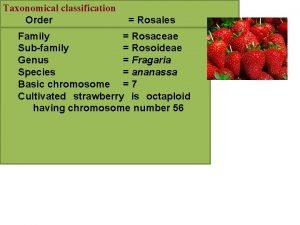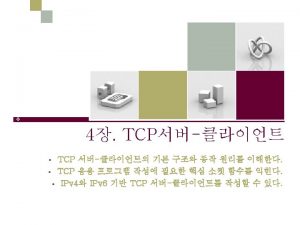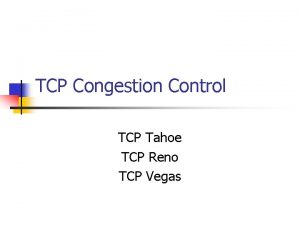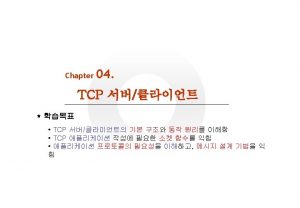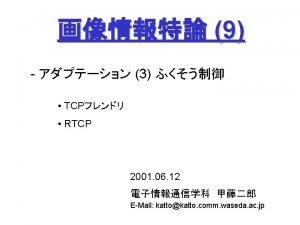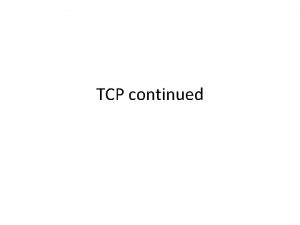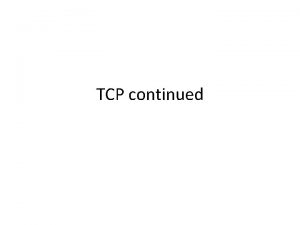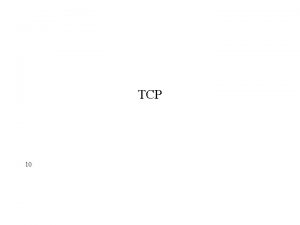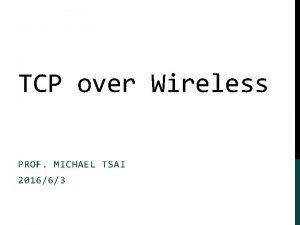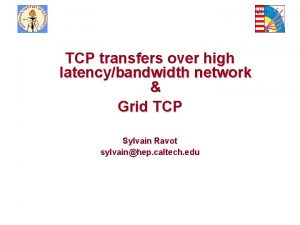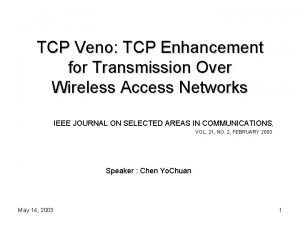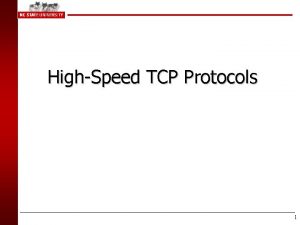Introduction Issues Design Goals Classifications TCP Over Ad















- Slides: 15

§ Introduction § Issues § Design Goals § Classifications § TCP Over Ad Hoc Wireless Networks § Other Transport Layer Protocols NAVEEN RAJA. V UNIT-V Transport Layer protocols for Ad Hoc Wireless Networks 1

INTRODUCTION: NAVEEN RAJA. V • The objectives of a transport layer protocol include setting up of: • End-to-end connection • End-to-end delivery of data packets • Flow control • Congestion control • Transport layer protocols • User Datagram Protocol (UDP): It is simplest Transport Layer communication protocol available of the TCP/IP protocol suite. It involves minimum amount of communication mechanism. Unreliable and connection-less transport layer protocols. It send short packets of data, called datagrams. • Transmission Control Protocol (TCP): It is one of the main protocols in TCP/IP networks. Whereas the IP protocol deals only with packets, TCP enables two hosts to establish a connection and exchange streams of data. TCP guarantees delivery of data and the delivery in the same order in which they were sent. It is reliable, byte-stream 2 based, and connection-oriented transport layer protocols. • These traditional wired transport layer protocols are not suitable for ad hoc wireless networks.

• Issues while designing a transport layer protocol for ad hoc wireless networks: • Induced traffic refers to the traffic at any given link due to the relay traffic through neighboring links. • Induced throughput unfairness refers to the throughput unfairness at the transport layer due to the throughput/delay unfairness existing at the lower layers such as the network and MAC layers. • Separation of congestion control, reliability, and flow control could improve the performance of the transport layer. • Power and bandwidth constraints affects the performance of a transport layer protocol. • Misinterpretation of congestion occurs in ad-hoc wireless networks. • Completely decoupled transport layer needs to adapt to the changing network environment. • Dynamic topology affects the performance of a transport layer. NAVEEN RAJA. V ISSUES: 3

• The protocol should maximize throughput per connection. • It should provide throughout fairness across contending(challenging/oppose) flows. • It should minimize connection setup and connection maintenance overheads. • The protocol should have mechanisms for congestion control and flow control in the network. • It should be able to provide both reliable and unreliable connections. • The protocol should be able to adapt to the dynamics of the network. • One of the important resources must be used efficiently. • The protocol should be aware of resource constraints. • The protocol should make use of information from the lower layer. • It should have a well-defined cross-layer interaction framework. • The protocol should maintain end-to-end semantics. NAVEEN RAJA. V DESIGN GOALS: 4

Transport Layer Solutions for Ad Hoc Wireless Networks TCP over ad-hoc wireless networks Split Approach Split-TCP End-to-end approach Other transport layer approach ACTP ATP NAVEEN RAJA. V CLASSIFICATION OF TRANSPORT LAYER SOLUTIONS TCP-ELFN TCP-F TCP-Bus ATCP 5

• TCP taking 90% of the traffic is predominant in the Internet. • This chapter focuses on TCP extension in ad hoc wireless networks. • Transport protocol should be independent of the network layer technology, e. g. , no matter fiber or radio is used • But TCP is optimized for wired network Congestion control • TCP assumes timeout is due to congestion • Wireless links are not reliable, packet loss may be as high as 20% • In wired network, packet loss is due to congestion slow down • In wireless network, due to wireless links try harder NAVEEN RAJA. V TCP OVER AD-HOC WIRELESS NETWORKS: 6

• Misinterpretation of packet loss • Frequent path breaks • Effect of path length • Misinterpretation of congestion window • Asymmetric link behavior • Uni-directional path: TCP ACK requires RTS-CTSData-ACK exchange • Multipath routing • Network partitioning and remerging • The use of sliding-window-based transmission NAVEEN RAJA. V WHY DOES TCP NOT PERFORM WELL IN AD-HOC WIRELESS NETWORKS: 7

• Split-TCP • provides a unique solution to the channel fairness problem by splitting the transport layer objectives into congestion control and end-to-end reliability. • Splits a long TCP connection into a set of short concatenated TCP connections with a number of selected intermediate nodes as terminating points of these short connections. • Advantages • Improved throughput fairness • Reduced impact of mobility • Disadvantages • It requires modifications to TCP protocol. • The end-to-end connection handling of traditional TCP is disturbed. • The failure of substitution nodes can lead to throughput degradation. NAVEEN RAJA. V TCP OVER AD HOC WIRELESS NETWORK: 8

…. cntd • TCP with Explicit Link Failure Notification (TCP-ELFN) • Handle explicit link failure notification • Use TCP probe packets for detecting the route reestablishment. • The ELFN is originated by the node detecting a path break upon detection of a link failure to the TCP sender. • Advantages: • improves the TCP performance by decoupling the path break information from the congestion information by the use of ELFN. • Less dependent on the routing protocol and requires only link failure notification • Disadvantages • When the network is partitioned, the path failure may last longer • The congestion window after a new route is obtained may not reflect the achievable transmission rate acceptable to the network and TCP receiver. NAVEEN RAJA. V TCP OVER AD HOC WIRELESS NETWORK: 9

…. cntd • Feedback-based TCP (TCP Feedback – TCP-F) • Requires the support of a reliable link layer and a routing protocol that can provide feedback to the TCP sender about the path breaks. • The routing protocol is expected to repair the broken path within a reasonable time period. • Advantages: Simple, permits the TCP congestion control mechanism to respond to congestion • Disadvantages: • If a route to the sender is not available at the failure point (FP), then additional control packets may need to be generated for routing the route failure notification (RFN) packet. • Requires modification to the existing TCP. • The congestion window after a new route is obtained may not reflect the achievable transmission rate acceptable to the network and the TCP-F receiver. NAVEEN RAJA. V TCP OVER AD HOC WIRELESS NETWORK: 10

TCP OVER AD HOC WIRELESS NETWORK: …. cntd NAVEEN RAJA. V • TCP with Buffering capability and Sequence Information(TCP-Bu. S) • Use feedback information from an intermediate node on detection of a path break. • Use localized query (LQ) and REPLY to find a partial path • Upon detection of a path break, an upstream intermediate node originates an explicit route disconnection notification (ERDN) message. • Advantages • Performance improvement and avoidance of fast retransmission • Use on-demand routing protocol • Disadvantages • Increased dependency on the routing protocol and the buffering at the intermediate nodes • The failure of intermediate nodes may lead to loss of packets. • The dependency of TCP-Bu. S on the routing protocol many 11 degrade its performance.

…. cntd • Ad Hoc TCP (ATCP) • uses a network layer feedback mechanism to make the TCP sender aware of the status of the network path • Based on the feedback information received from the intermediate nodes, the TCP sender changes its state to the persist state, congestion control state, or the retransmit state. • When an intermediate node finds that the network is partitioned, then the TCP sender state is changed to the persist state. • The ATCP layer makes use of the explicit congestion notification (ECN) for maintenance for the states. • Advantages • Maintain the end-to-end semantics of TCP • Compatible with traditional TCP • Provides a feasible and efficient solution to improve throughput of TCP • Disadvantages • The dependency on the network layer protocol to detect the route changes and partitions • The addition of a thin ATCP layer to the TCP/IP protocol changes the interface functions currently being used. NAVEEN RAJA. V TCP OVER AD HOC WIRELESS NETWORK: 12

• Application Controlled Transport Protocol (ACTP) • A light-weight transport layer protocol and not an extension to TCP. • ACTP assigns the responsibility of ensuring reliability to the application layer. • ACTP stands in between TCP and UDP where TCP experiences low performance with high reliability and UDP provides better performance with high packet loss in ad hoc wireless networks. • Advantages • Provides the freedom of choosing the required reliability level to the application layer. • Scalable for large networks • There is no congestion window • Disadvantages • It is not compatible with TCP. • Could lead to heavy congestion NAVEEN RAJA. V OTHER TRANSPORT LAYER PROTOCOLS: …. cntd 13

…. cntd • Ad hoc Transport Protocol (ATP) • specifically designed for ad hoc wireless networks and is not a variant of TCP and differ from TCP in the following ways: • Coordination among multiple layers • Rate based transmissions • Decoupling congestion control and reliability • Assisted congestion control • ATP uses information from lower layers for • Estimation of the initial transmission rate • Detection, avoidance, and control of congestion • Detection of path breaks • Advantages: improved performance, decoupling of the congestion control and reliability mechanisms, and avoidance of congestion window fluctuations • Disadvantages: • The lack of interoperability with TCP • Fine-grained per-flow timer may cause the scalable problem NAVEEN RAJA. V OTHER TRANSPORT LAYER PROTOCOLS: 14

NAVEEN RAJA. V COMPARISION OF TCP SOLUTIONS FOR ADHOC WIRELESS NETWORKS 15
 Strategic goals tactical goals operational goals
Strategic goals tactical goals operational goals Strategic goals tactical goals operational goals
Strategic goals tactical goals operational goals Itcp in mobile computing
Itcp in mobile computing General goals and specific goals
General goals and specific goals Motivation in consumer behaviour
Motivation in consumer behaviour Over the mountain over the plains
Over the mountain over the plains Siach reciting the word over and over
Siach reciting the word over and over Handing over and taking over the watch
Handing over and taking over the watch Very strongly flavored vegetables
Very strongly flavored vegetables 5 classification of vegetables
5 classification of vegetables Mildly flavored vegetables cooking methods
Mildly flavored vegetables cooking methods Rosales
Rosales Solanaceae
Solanaceae Two classifications of shellfish
Two classifications of shellfish Classifications of oblique triangles
Classifications of oblique triangles Flis reportable events
Flis reportable events











